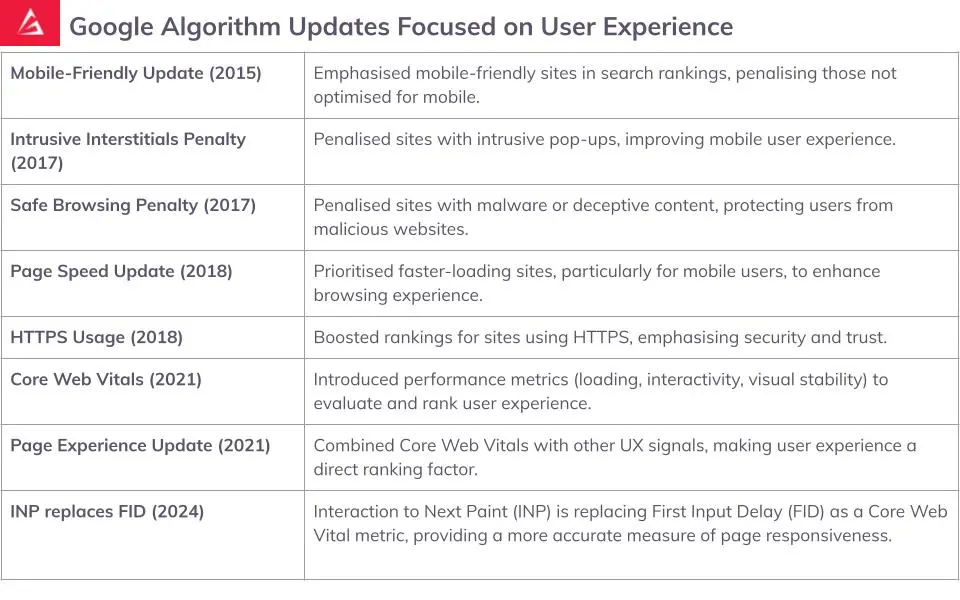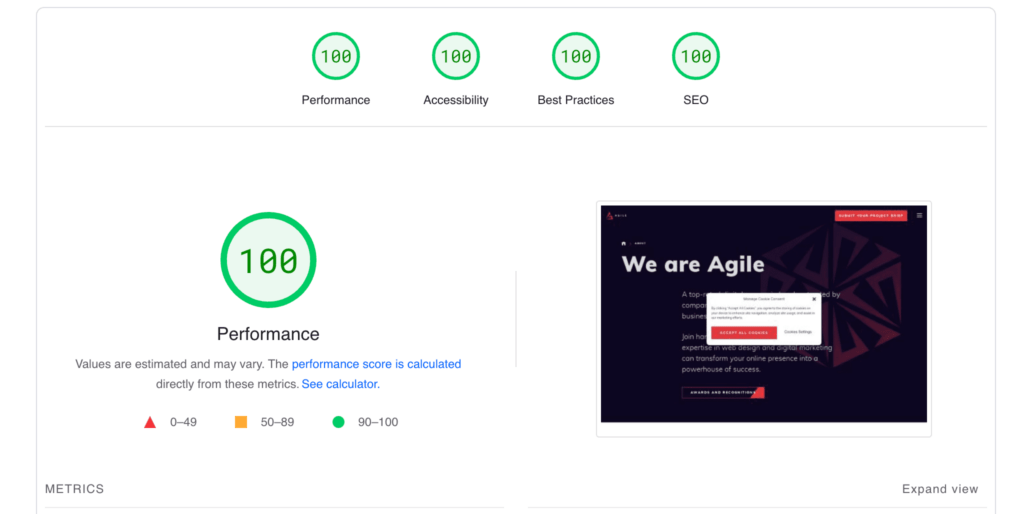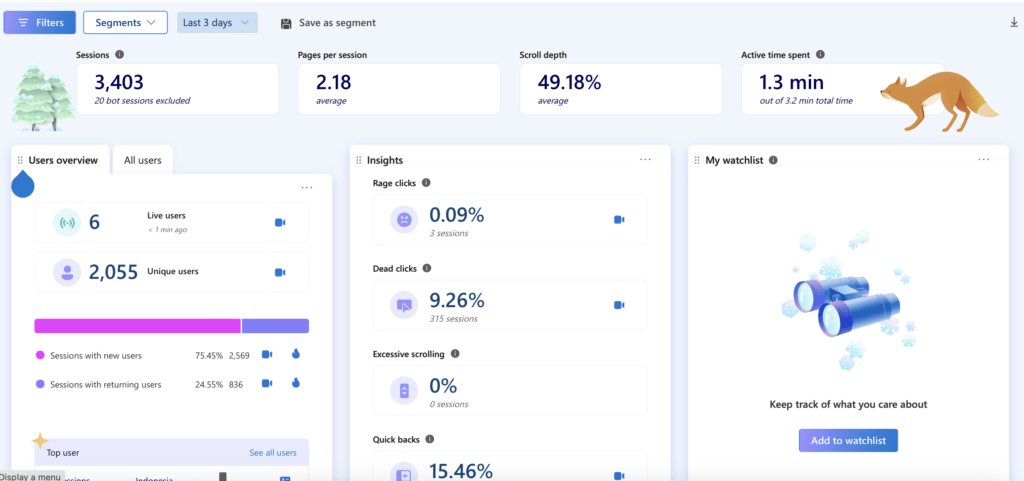How User Experience Affects SEO
For professional services businesses, user experience (UX) and SEO go hand in hand when it comes to creating a successful website. If your site is difficult to navigate, slow to load, or unattractive, chances are you won’t rank very high on search engines.
In this article, we’ll explore how User Experience affects SEO and what you can do to improve both. Let’s dive into it!
In this article:
The Fundamentals of User Experience
Defining User Experience (UX)

User Experience (UX) encompasses the overall experience a visitor has while interacting with a website or application. It involves elements such as usability, accessibility, responsiveness, and aesthetics.
Studies show that 88% of online consumers are less likely to return to a site after a bad experience (source: SWEOR). Thus, prioritising UX is paramount for retaining and engaging users.
Key Elements of User Experience
Creating an exceptional user experience (UX) is crucial for the success of any website. UX encompasses several key elements that ensure users have a positive, efficient, and enjoyable interaction with your site.
These elements include usability, accessibility, responsiveness, and more. Understanding and implementing these principles can greatly enhance user satisfaction and improve overall website performance.

Below, we explore the fundamental components that contribute to an effective user experience:
- Usefulness: The website should provide valuable and relevant content to users. This includes practical and functional benefits, such as providing necessary information or enabling transactions, as well as non-practical benefits like entertainment, aesthetic appeal, or emotional satisfaction.
- Usability: The website should be easy to use and navigate, allowing users to achieve their goals efficiently and effectively. This involves clear navigation, intuitive interfaces, and straightforward interactions.
- Responsiveness: The website should be designed to adapt seamlessly to different devices and screen sizes.
- Availability: The website should be accessible and available to users when they need it. This includes ensuring that the site is easily discoverable through search engines and accessible through various channels and devices.
- Reliability: The website should be reliable and consistent in its performance. This means ensuring that the site loads quickly, functions as expected, and is dependable, providing users with a seamless experience every time they visit.
- Desirability: The website should be visually appealing and enjoyable to use, providing a positive emotional experience. This includes attractive design, engaging content, and an overall pleasant user experience.
- Accessibility: The website should be accessible to all users, regardless of their abilities or disabilities. This includes ensuring compatibility with assistive technologies and providing alternative text for images, transcripts for videos, and navigable content structures.
- Valuation: The website should be valued by users, meaning that it should meet their needs and expectations, providing a satisfying and fulfilling experience. This includes ensuring that the content is relevant, the design is appealing, and the overall experience is positive.
Additionally, the 5 elements of UX design, as outlined by Jesse James Garrett, include:
- Strategy: Defining the objectives and goals of the website, including both business and user needs. This involves understanding what the website aims to achieve and how it will serve its users.
- Scope: Defining the functional and content requirements of the website, including the features and information that users can access. This involves deciding what the website will offer to its users in terms of content and functionality.
- Structure: Defining the navigation and interaction design of the website, including how users will interact with the system and how it will respond to their actions. This involves creating a logical flow and structure that makes it easy for users to find what they need.
- Skeleton: Defining the information architecture of the website, including how the content is structured and organised. This involves creating a clear layout that guides users through the content in an intuitive way.
- Surface: Defining the visual design and user interface of the website, including the layout, colours, and typography. This involves creating an aesthetically pleasing and consistent design that enhances the user experience.
These elements work together to create a cohesive and effective user experience that meets users’ needs and expectations, ensuring that the website is not only functional but also engaging and enjoyable to use.
The Role of User-Centred Design
User-centred design focuses on designing products and services that meet the needs and preferences of users. It involves conducting user research, gathering feedback, and iterating on designs based on user input.

By prioritising user experience, professional services firms can create websites that not only convert leads but also build trust and credibility.
To learn more, read Craig Nishizaki’s article about the benefits of user-centric design and the role of UX strategy.
How User Experience (UX) Affects SEO Rankings
UX is about creating a seamless and enjoyable experience for visitors to your website. This includes the layout and design of your site and how easy it is to find information and navigate through different pages.
SEO, or search engine optimisation, is about making sure your website ranks well in search engine results.
The two may seem unrelated, but they are closely intertwined. Google and other search engines take user experience into account when determining where a site should rank in search results.

If your business website is difficult to use or doesn’t provide the information users are looking for, it won’t rank very high.
SEO happens before the first click, and usability takes over from there. Both need to be good for a website to succeed. Having great SEO but lousy usability means that you’ll get lots of traffic, but the visitors won’t turn into customers. Conversely, a site with great usability but lousy SEO simply won’t get many visitors, so it doesn’t really matter how good it is.
Jakob Nielsen
How User Experience (UX) Impacts SEO Performance
So, how exactly does UX affect SEO?
Well, for starters, search engines like Google want to provide their users with the best possible results.
This means they want to send people to websites that are easy to use, informative, and trustworthy.
If your website has a high bounce rate (meaning people leave shortly after arriving) or low dwell time (time on page), this could signal to search engines that your site isn’t meeting the needs of users.
User engagement metrics, such as engagement rate, click-through rates (CTR), and time on page, are key indicators of how users interact with a website. Does site engagement affect SEO? Absolutely. Search engines use these metrics to gauge the relevance and quality of a website’s content.
Websites with higher engagement rates and longer average session durations are more likely to rank higher in search results because they indicate that users find the content valuable and engaging.
In addition, factors like page load speed and mobile responsiveness also play a significant role in SEO, ensuring users can easily navigate and interact with the site.

If your site takes forever to load or looks terrible on a smartphone, then search engines may penalise you in their rankings. After all, they want to direct users to websites that offer a smooth and seamless experience across all devices.
Related: Enhancing Mobile Website Performance for Superior SEO Results
Improving User Experience (UX) to Boost SEO Performance
Now that we understand the connection between user experience and SEO, let’s talk about what you can do to improve both.
1. Think About Your Audience’s Needs
One of the first steps is to think about your target audience and what they’re looking for when they visit your site. Are they searching for information? Looking to make a purchase? Trying to contact me?
By understanding the needs and goals of your visitors, you can tailor your site to provide the best possible experience.
2. Optimise Website Navigation
Intuitive and user-friendly navigation is essential for guiding visitors through a website and helping them find the information they need quickly and easily.
By optimising website navigation, businesses can reduce bounce rates and improve user engagement, ultimately leading to better SEO performance.
3. Create Quality Content
At the end of the day, content is still king when it comes to SEO. Providing well-written, relevant content that answers users’ questions or solves their problems is key to keeping them engaged and coming back for more.
Search engines love fresh, high-quality content, so make sure you’re regularly updating your site with new blog posts or articles.
4. Optimise for User Intent
Understand what users are searching for and why they’re searching for it.
By creating content that aligns with user intent and providing a seamless user experience, you’ll increase the likelihood of ranking higher in search results.
5. Improve Website Design and Layout
Pay attention to the design and layout of your website. Is it easy to navigate? Are important information and CTAs (calls-to-action) clearly visible? Simplicity is key.
Don’t overload your site with unnecessary elements or clutter – keep it clean and organised so visitors can easily find what they’re looking for.
Read also: 7 Deadly Sins of Website Design: How to Avoid Online Failure
6. Ensure Accessibility
While not a direct ranking factor, improving accessibility ensures that all users, including those with disabilities, can access and use your website effectively.
By incorporating accessibility best practices, such as providing alternative text for images, clear navigation, and keyboard accessibility, you can enhance the overall user experience and make your website more inclusive
7. Make sure your site is fast to load
Users today have short attention spans and will quickly bounce off a site that takes too long to load. This not only affects user experience but can also hurt your SEO rankings.
Google considers page speed as a ranking factor, making it essential for websites to optimise their loading times for better SEO performance.
Optimising images, minimizing HTTP requests, and using browser caching are some strategies to improve loading speed and enhance user experience.
Use tools like Google’s PageSpeed Insights to check your site’s load time and make any necessary improvements.
And don’t forget about mobile responsiveness. With more people browsing the web on smartphones and tablets than ever before, your site must look great on all devices.
Read also: Core Web Vitals: Learn How to Improve for Better SEO
For additional insights, check out Google’s Search Off the Record episode on UX for SEO, where Lizzi, John and Rio discuss how user experience affects SEO and impacts search rankings.
Key User Experience (UX) Metrics That Impact SEO
When it comes to user experience, it’s important to not only focus on how your website looks but also how it functions. One way to measure the effectiveness of your website’s design and layout is through user experience metrics. These metrics can give you valuable insights into how well your site is performing and where improvements can be made.
What are the key metrics that both UX and SEO share?
1. Page Views and Click Depth
- Page Views: This metric tracks how often a page is viewed, indicating whether users find the content they seek. High page views usually correlate with effective SEO practices that attract users.
- Click Depth: This measures how many clicks it takes for a user to reach a particular page from the homepage. A lower click depth is preferred as it suggests that users can easily navigate to desired content, enhancing both UX and SEO performance
2. Bounce Rate
- Bounce Rate: This measures the percentage of visitors who leave your site after viewing only one page. A high bounce rate can indicate that users are not finding what they’re looking for or are having trouble navigating your site.
3. Conversion Rates
- Conversion Rate: This metric tracks the percentage of visitors who take a desired action on your site, such as making a purchase or signing up for a newsletter. Analysing conversion rate data can help you identify barriers preventing users from converting and make improvements to increase conversions.
4. User Engagement Metrics
- Time on Page: This measures how long users spend on a specific page of your site. This can give you an idea of how engaging your content is and whether users are finding value in what you offer.
- Click-Through Rate (CTR): This ratio counts the number of visitors to a page who click on a link out of all visitors. More click-through rates from search results can be a sign of successful SEO and compelling UX design.
- Dwell Time: This refers to the time a user spends on a page before returning to the search results. Longer dwell times are indicative of content quality and relevance, which can positively influence rankings
5. Core Web Vitals
- Core Web Vitals: These are specific metrics established by Google that assess the user experience based on loading performance, interactivity, and visual stability of a page. Improving these metrics can enhance both UX and SEO, as they are crucial for search engine rankings.
6. Mobile Responsiveness
- Mobile-Friendly Design: As mobile traffic continues to rise, having a website that performs well on mobile devices is critical. This metric affects both user satisfaction and SEO rankings, as search engines prioritise mobile-friendly sites.
By focusing on SEO and UX metrics, and making data-driven decisions, you can create a website that not only looks great but also functions effectively.
Use tools like Microsoft Clarity to check how your users are interacting with your website. This will give you valuable insights into user behaviour, helping you identify areas for improvement and optimise your site for a better user experience.

Remember, user experience is key to keeping visitors engaged and coming back for more, so be sure to prioritise it in your website design strategy.
Monitoring SEO Performance Metrics to Improve UX and Rankings
In addition to user experience metrics, monitoring SEO performance metrics such as keyword rankings, organic traffic, and backlink profiles is essential for evaluating the effectiveness of SEO strategies.
By analysing these metrics alongside user experience data, businesses can identify trends and make informed decisions to optimise their website for both users and search engines.
Conclusion
User experience and SEO are more closely connected than you might think.
By focusing on creating a website that is easy to navigate, fast to load, mobile-friendly, and filled with high-quality content, you can improve both user experience and SEO rankings.
So next time you’re working on your website, keep these factors in mind and watch as your site climbs higher in the SERPs!
Agile is an independent Digital Marketing Agency headquartered in London, specialising in web design and search engine optimisation. Our proficiency is underscored by several HubSpot Certifications, and we take pride in being recognised as a 2023 Global Award Winner for SEO by Clutch. At the heart of our success lies a team that seamlessly navigates the intersection of technology and marketing, ensuring innovative and impactful solutions for our clients.
Related
Articles


